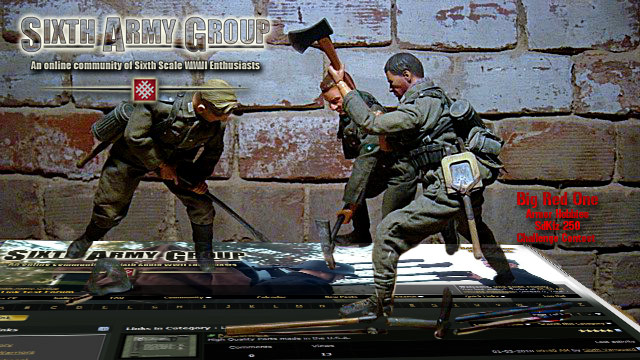Johnny Canuck
Battalion Commander
Hello Mr V
Geoff Truscott here, we met briefly at the resent Kingston show.
I'm getting to a stage with "Les Boys", "Sand Dust and Gravel" RRR's and the Kangaroo crews that I need to consider adding badges, insignia etc. They're looking pretty generic.
The units are all Canadian ETO 1944-45.
3rd Cdn Inf. Division
Regina Rifle Regiment 7th Brigade
Le regiment de la Chaudiere 8th Brigade
SDG 9th Brigade
7th reconnaissance Regiment (17th Duke of York's Royal Canadian Hussars)
Cameron Highlanders of Ottawa MG Battalion
1st CACR
Royal Canadian Artillery
I have a copy of Canadian soldier which outlines the basics of layout but doesn't cover what actually happened in the field.
In actual combat the colourful parade finery would just attract a piece of lead. What insignia, badges, etc were worn?
Heard reference to some Canadian officers ditching their Officer caps for a helmet and Sten for an Enfield rifle that always worked. German snipers loved those hats.
I seem to notice that less and less is visible as the war progresses through to 1945. Divisional patch (3rd French Grey) and rank come to mind as being visible late war (?) the rest seems to have removed or never attached.
Armour is a good example of this change, D-Day Big White Stars all over everything and no camo. By 1945 the Big White Star had been eliminated except for ontop of the turret for Allied Air Recognition. The hull had serial number, unit crest and perhaps a Pet Name. Sand bags, tracks, logs or whatever; used to defend against Hollow Charge weapons, obscured most of the visible hull anyways. Also camo seems to have been employed to a higher degree by late 44.
Anyways back to my original thought. What is your take on the changes if any, in the use of insignia by 3rd Cdn Inf. Div ETO 1944-45.
Geoff
Geoff Truscott here, we met briefly at the resent Kingston show.
I'm getting to a stage with "Les Boys", "Sand Dust and Gravel" RRR's and the Kangaroo crews that I need to consider adding badges, insignia etc. They're looking pretty generic.
The units are all Canadian ETO 1944-45.
3rd Cdn Inf. Division
Regina Rifle Regiment 7th Brigade
Le regiment de la Chaudiere 8th Brigade
SDG 9th Brigade
7th reconnaissance Regiment (17th Duke of York's Royal Canadian Hussars)
Cameron Highlanders of Ottawa MG Battalion
1st CACR
Royal Canadian Artillery
I have a copy of Canadian soldier which outlines the basics of layout but doesn't cover what actually happened in the field.
In actual combat the colourful parade finery would just attract a piece of lead. What insignia, badges, etc were worn?
Heard reference to some Canadian officers ditching their Officer caps for a helmet and Sten for an Enfield rifle that always worked. German snipers loved those hats.
I seem to notice that less and less is visible as the war progresses through to 1945. Divisional patch (3rd French Grey) and rank come to mind as being visible late war (?) the rest seems to have removed or never attached.
Armour is a good example of this change, D-Day Big White Stars all over everything and no camo. By 1945 the Big White Star had been eliminated except for ontop of the turret for Allied Air Recognition. The hull had serial number, unit crest and perhaps a Pet Name. Sand bags, tracks, logs or whatever; used to defend against Hollow Charge weapons, obscured most of the visible hull anyways. Also camo seems to have been employed to a higher degree by late 44.
Anyways back to my original thought. What is your take on the changes if any, in the use of insignia by 3rd Cdn Inf. Div ETO 1944-45.
Geoff
